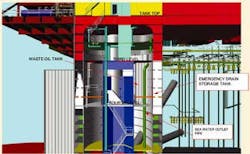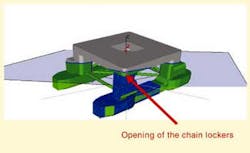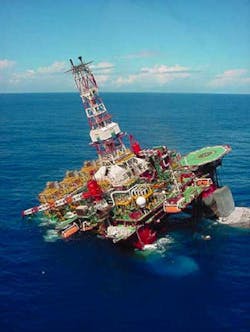FLOATING PRODUCTION: Location of tanks in P-36 columns questioned as Petrobras wraps up inquiry
The final report on the P-36 sinking off Brazil last March sheds light on the sequence of events leading to the disaster and makes recommendations about designs and procedures. Future changes also were recommended that would make it easier to investigate such a disaster after the fact. One proposal was the development of a "black box" similar to what is carried on airliners. While these results will be taken to heart by operator Petrobras, they have ramifications for the entire industry.
There is international interest in what caused the two explosions aboard the P-36, and secondarily, why the vessel could not be prevented from sinking. As other large semisubmersible vessels prepare to enter the market, operators and owners are following the developments in Brazil. Some recommended changes may be difficult to implement at certain stages of design and construction. Others are more procedural in nature.
The preliminary report on the P-36 disaster was generated by an inquiry commission made up of eight Petrobras employees, a representative of the labor union, and a representative from the Federal University of Rio de Janeiro. The commission mapped out a course of action, dividing it into seven steps, beginning with gathering information and analyzing the evidence. A preliminary report was published early in June with the final report made public later that month. The final report provided a closer analysis of the cause of the accident and included a draft of corrective action.
Impact future designs
The future design of floating produc-tion vessels could be impacted by the commission results, possibly compelling operators to modify designs already in place. The results should be valuable for anyone building any type of production vessel in the future.
Unfortunately, the greatest source of accident information is lying upside down at the bottom of the ocean in deepwater. Aside from examining the vessel itself with remotely operated vehicles, the commission gathered information by conducting interviews, gather documentation material from the operator, and reviewed platform project documents. Because the actual sinking of the vessel took almost five days, there are a wide range of videotapes and photos documenting the event itself. These were collected by the commission along with news reports from the media. Frustrated by the limited information available from the vessel itself, the commission looked into ways such a sunk vessel could better assist in future investigations. If critical information could be stored in an onboard retrievable system, it could aid in the recreations of such events.
First, second explosions
The one area of greatest interest, the initial explosion, occurred in the middle of the night, and there seem to be many questions as to the exact cause. It is the opinion of the commission that the first explosion was caused by pressure buildup in an emergency drain storage tank located on the fourth floor, high in the damaged starboard aft column.
A control valve, left partially open, apparently allowed gas, followed by water, to enter the tank from processing equipment on the deck. The gas and oil created pressure that eventually burst the tank. Thus, the first explosion may have been a burst tank, rather than a gas explosion as was originally thought.
This damage, and the resulting flow of gas, oil, and water from the damaged tank into the column, caused the vessel to tip two degrees off level within five minutes. The damage also caused the fire-fighting network to lose pressure. The escaping gas built up pressure in the column, while the fire-fighting team, responding to the first "explosion," made their way to the scene.
Seventeen minutes after the emergency tank burst, the leaking gas apparently reached saturation point in the top of the column. An ignition source set off the gas and caused a large explosion, which eventually killed 11 men on the fire-fighting team. The second explosion and subsequent shock waves further destabilized the vessel, as water began pouring in from several ruptured water lines used for a variety of purposes, such as fire, refrigeration, etc. Damage to the sea water pumps and sea water service pipe made it difficult to displace any of the water entering the column.
Once the column began taking on water, pumping stations, propellers and the water injection area were covered in water that made its way through the ventilation shaft. As the vessel became more unstable, it was completely abandoned. Once the vessel list reached 16 degrees, it passed what many in the industry consider a critical point for continued flotation.
16-degree cut off
There are a number of openings in the decks of these columns, necessary for a variety of functions. At 16 degrees tilt, the vessel officially exceeded a "projected critical point for maximum damage." At this tilt, port holes, anchor chain ports, doors, and vent hoods of the buoyancy tanks were exposed to the open sea. At this tilt point, the openings of anchor chain lockers were 54 cm below the water line. Gaining access through ruptured internal structures (ventilation shafts, open bulkheads or doors, or ruptured pipes), water entered other sections of the vessel. Eventually, the extent of flooding was so advanced, there was no way to close off all the water entry sources, and the vessel simply rolled over and sank.
There was some consideration about the failure of the vessel's seawater inlet valves, which were designed to fail closed, but remained open, taking on water through the sea chest.
Conclusions
The key goal of this investigation was to determine the causes of the accident so they may be avoided in the future. While it is helpful to identify what sank P-36, the recommendations of the commission recognize the fact that the circumstances of this disaster were unique. Thus the recommendations were more general. Among those are the following:
- Better coordination between the supervision of the production platform activity and the activities controlling platform stability. Coordinating the two would avoid hydrocarbons being introduced into the support columns.
- Reduce bureaucracy so supervisors spend less time on paper work and more time trouble shooting potential problems with the rig.
- Assure there is adequate crew to perform and supervise the functions of more complex rigs such as P-36.
- Restructure maintenance activities to emphasize timely, preventative maintenance is performed by qualified personnel.
- Ensure risk analysis is given priority before any alterations in the project are made.
- Include more technical training in the area of ballast and stability control specific to each platform.
- Establish a system where, prior to evacuation of a platform, key information is copied or otherwise recovered. This could take the form of a "black box" design for recovering information in the event of an emergency.
Beyond these, some specific recommendations were made that seem related to this disaster in particular. Project requirements and E&P safety should be reevaluated concerning more rigorous classification of areas. Restrictions should be placed on the use of alternative requirements for stabilization in the event of damage. Restrictions should be placed on the use of vital common systems such as refrigeration, ballast, and fire-fighting, which were damaged in this accident. The use of fail-set valves in ballast systems also should be reexamined. Likewise, the number of ballast pumps interlinked in the case of an emergency. Alarms should be prioritized to avoid excess information arriving in the control room in the event of an emergency.
In general the emergency procedures and plans should be upgraded to cover the following areas:
- The fire-fighting crew should proceed directly to the location of the occurrence.
- Compartments are to remained sealed in case of flooding.
- Identify means to be used in case of an evacuation, for example, cranes and lifeboats.
- Portable gas detectors should be used for continuous monitoring with visual and sound alarms.
- Clarify how communication systems are to be used during an emergency.
What next
One of the purposes of the study was to make recommendations for future designs. While there has been little in the way of concrete results, recommendations based on hypotheses include not putting tanks or receptacles inside columns or pontoons that are connected to processing activities. This alone has the potential of a broad impact on industry practice.
The commission readily admits that the location of such tanks in columns is "acceptable industry practice." In its recommendations, the commission calls upon oil companies to make a "management decision" to eliminate the tanks.
"In the case of existing platforms, that have receptacles and tanks inside the columns or pontoons and are connected to the processing activities, companies are advised to re-analyze the projects in light of the operational risk."
As for Petrobras and the Roncador field, upon which the P-36 had reached a production level of 80,000 b/d when the accident occurred, it will be a slow recovery, in every sense. Petrobras has received its insurance settlement for the loss of the P-36.
The bulk of the $500 million settlement, $325 million, will go to pay off the lease on the lost rig. As work continues to determine the exact cause of this disaster, Petrobras is planning to replace the 80,000 b/d the rig had been producing.
The first move was to focus attention on the Marlim Sul Field. Equipment such as flowlines and christmas trees originally slated for Roncador have been rerouted to support Marlim Sul. Likewise, support vessels, rigs, and boats, were redirected to Marlim Sul.
Resume production
In 3Q 2002, Petrobras plans to resume scheduled production on Roncador. The field will be tied to an FPSO (floating production, storage, and offloading) vessel for Phase 1 production - the phase the field was in when P-36 was lost. The FPSO will either be a 90,000 b/d charter, or a conversion of the P-47 floating production vessel that was supporting P-36. This FPSO will take over production of 90,000 b/d and 3.2 MMcf/d from five P-36 wells and another six that will be brought on stream. While the production unit and riser system were a total loss, the flowlines and subsea equipment remain in excellent condition, according to Petrobras.
For Phase 2 production, scheduled to come on in 2004, a new vessel with 180,000 b/d capacity will come onstream. This vessel is scheduled to take over production of the Phase 1 wells in 2007 to reach the 180,000 b/d figure.




